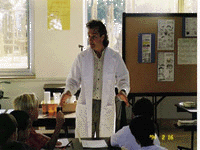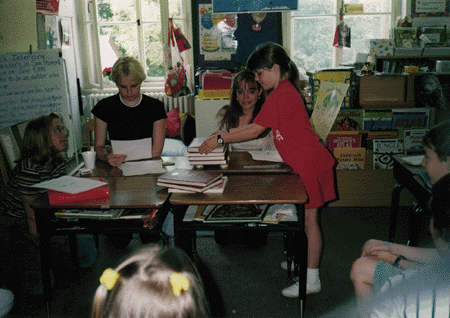| Sharing Science | |||||||||||
| Kids Teaching Kids: Student Outline | |||||||||||
| Be An Einstein...Ask Why? | |||||||||||
| On-Line Physics | |||||||||||
| Enrichments | |||||||||||
| Collaboratives | |||||||||||




"Kids Teaching
Kids" Program
The silence was overwhelming. In the middle of the room a group of first graders sat, dazzled by what seemed to be magic. Their eyes focused carefully on every detail of the demonstrations being performed. As physical changes occurred, the students unconsciously crept closer and closer to the demonstration apparatus.
"Who would like to volunteer for the following demonstration?" "Me! Me! Me!" A handful of hands sprouted up, each one trying to reach higher than the others. The first graders in the front thought they had an advantage and got up, blocking the others, still waving their hands frantically. In the end, everybody got their turn.
This excerpt is from a collaborative program that my wife and I developed called "Kids Teaching Kids" as an effort to upgrade hands-on enjoyable science experiences for our students. These hands-on activities and programs are used for the larger scale advocacy to promote the sharing and integration of science. We have utilized a hands-on approach known as a "Physics Roadshow" for a number of years to focus our attention on collaborative science activities. This previous program was used to enhance and enrich science education for elementary and secondary students and teachers.
From the practical approaches of the "Kids Teaching Kids" program we started a spin-off program called "Be an Einstein....Ask Why?". This program was established as a continuation of and a building on to the previous collaborative activities of sharing. It clearly allows for the enrichment of science education for our students.
This program, if attempted, can develop a solid foundation
of sharing science programs for a larger group of students
and teachers at the elementary level.
If you would like any information on these or other collaborative programs please use the following e-mail address: send mail to kskrutvold@uswest.net.